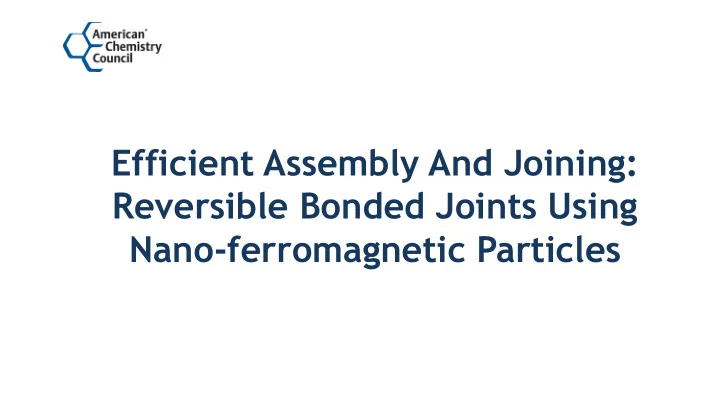

Efficient Assembly And Joining: Reversible Bonded Joints Using Nano-ferromagnetic Particles
ACC Automotive Team • Increase P&PC in automotive • Provide transformative innovations • www.Plastics-car.com
Research Project Reversible Bonded Joints Concept: Address need: fast, robust process for joining dissimilar materials • • Develop technology for joining composites and other lightweight materials • ACC sponsored research project at MSU, assisted by CAR Multi-Phase project demonstrating reversible bonded joints • • Use thermoplastic polymer adhesive, modified with nano-ferro-magnetic particles Enable multi-material assemblies (repairable) • Example: - Composite inner assembly Vehicle Closure - Aluminum outer skin
Research Project Reversible Bonded Joints Objectives: Enable efficient multi-material joining and assembly • • Allow for easy and rapid assembly, disassembly, re-assembly and repair • Capable of easy transition to current industry/assembly processes • Enable efficient load transfer, eliminate stress-concentration and strength reduction at joints Allow for part consolidation and other benefits possible with composites • • Reduce vehicle weight and in-turn, improve fuel economy and reduce emissions
Research Project Reversible Bonded Joints Approach: REVERSIBLE BONDED ADHESIVES • Thermoplastic adhesives reinforced with conductive nano-ferromagnetic particles Allow targeted heating of adhesive only • using electromagnetic fields METHODOLOGY Use integrated experimental and numerical approach that would eliminate costly trial- • and-error, and would instead use a rational computational materials based approach • Use of Non-Destructive Evaluation NDE) for joining efficiency, health monitoring • Develop business case to assess practical feasibility, manufacturing investment model
DoE – Technical Gaps for Vehicle Applications Source: http://www1.eere.energy.gov/vehiclesandfuels/pdfs/wr_ldvehicles.pdf This project addresses all the “Critical Concerns”: a) Dissimilar material Joining, b) Experimentally validate models/simulations / database creation, and c) efficient/rapid manufacturing and repair
MULTI-MATERIAL JOINING A COLLABORATIVE EFFORT FOR VEHICLE APPLICATION Business Case - Modeling Adhesive Joints Leading Interviewing OEM’s Bolted + Hybrid Joints Experts Industry + Academia MSU + CAR Dr. Haq Industrial Practices Novel, Reversible Joints Team & CVRC Multi- Disciplinary Tech. to Applications Team Novel, Multi-functional ACC & Adhesives MEMBERS Large-scale Manufacturing Financial Benefits & & Testing + Prototye Feasibility Development NOVEL FUNDAMENTAL VEHICLE BUSINESS CASE TECHNOLOGY RESEARCH APPLICATIONS MODELING
TEAM : Uniqueness & Pioneering the Effort on Combining Technology & Industrial Applications • Structural Multi- • Business Case material Joining Modeling • Novel, Tailorable Feasibility • Materials / Joints • OEM interactions Mr. Mark Stevens Dr. Haq et al. • Design Tools & applications et al. (CAR) (CVRC / MSU) NDE + Novel Materials Mr. Michael Day (CVRC / MSU) • Project • Dr. Drzal: Chemistry, (ACC) Management Novel Materials Facilitate CVRC, • • Dr. Udpa: NDE CAR and ACC interactions • Dr. Cloud: Joining
Progress to-date: • Adhesive resin development - twin-screw micro-extruder compounding nano-ferromagnetic material, thermoplastic adhesive • Adhesive films prepared - joining composite and aluminum samples. Lap shear joint samples – joint development, prelim. optimization • Initial characterization adhesive - thermodynamic properties eval. • • Installation of Induction system - activation adhesively bonded joint • Demonstrated reversible joint - lap shear specimens using inductive heating system • Collecting input from key industry partners - joining concept for developing business case Developing prelim. industry model - vehicle closure applications •
Thermophysical Characterization 160 140 0.5% FMNP Temprature, deg C 1% FMNP 120 2% FMNP 100 4% FMNP 8% FMNP 80 60 40 20 0 0 50 100 150 200 Time, sec Generally, presence of Ferromagnetic Nanoparticles (FMNP) was found to increase thermal • response of thermoplastic adhesive while subjected to electromagnetic field It was evident that at lower concentration (0.5 – 2.0 wt.%) FMNP , the thermal response of • the thermoplastic adhesive was insignificant; hence “threshold limit” is important to couple ‘thermal response’ with FMNP/induction heating
Thermophysical Characterization 160 140 Temperature, o C 120 100 Joint with 8% NFM 80 60 40 20 0 0.5% NFM 1% NFM 2% NFM 4% NFM 8% NFM 0.5 wt.% 1.0 wt.% 2.0 wt.% 4.0 wt.% 8.0 wt.% FerroMagnetic NanoParticle (FMNP) Content For the given Ferromagnetic Nanoparticles (FMNP) concentrations, the • trend shows an exponential regression • Again, it is evident that at lower concentration of (0.5-2.0 wt.%) FMNP , the thermal response is insignificant
Lap-Joint Shear Strengths: Similar Class of Adhesives Comparison of Shear Strengths of lap-joints with Similar Class of Adhesives 6 5 Shear Strength, MPa 4 3 2 1 0 1 2 Pristine Hot melt adhesive 8 wt.% FMNP Comparison - 1 Comparison – 2 Pristine Hot melt 8% NFM Hot melt adhesive Henkel Terokal 5089 adhesive 1 Elena Verna, Ermias Gebrekidan Koricho, Irene Cannavaro, Valentina Brunella, Giovanni Belingardi, DavideRoncato, BrunettoMartorana, Vito Lambertini, Vasilica Alina Neamtu, Romeo Ciobanu, Adhesive joining technologies activated by electro- magnetic external trims, International Journal of Adhesion and Adhesives, 2013:46;21-25 2 X.Yang, L. Yao, Yong Xia, Qing Zhou, Effect of base steels on mechanical behavior of adhesive joints with dissimilar steel substrates, International Journal of Adhesion and Adhesives, 2014;51:42-53
Accomplishment: Proof – of – Concept Proof of Concept – Disbonding of Joint through Activation of Reversible Adhesive
Business Case • Generic Business Case Target for bonded joint is being developed • Historical Range shows dependence on OEM specs. + other factors Next Steps: ◦ Review generic target with OEMs ◦ Program formula into the business case model ◦ Focus on dispensing methodology • Collecting data to ensure compelling case for technology uptake
For More Information Thank You Item 1 Mike Day, ACC Automotive Technology Consultant daymichael@att.net Item 2 This presentation was prepared by the ACC Plastics Division with input from experts from Michigan Item 3 State University’s CVRS and the Center for Automotive Research. Gina Oliver Senior Director, Automotive Plastics Item 4 ACC Plastics Division Gina-Marie_Oliver@americanchemistry.com www.Plastics-Car.com
Recommend
More recommend